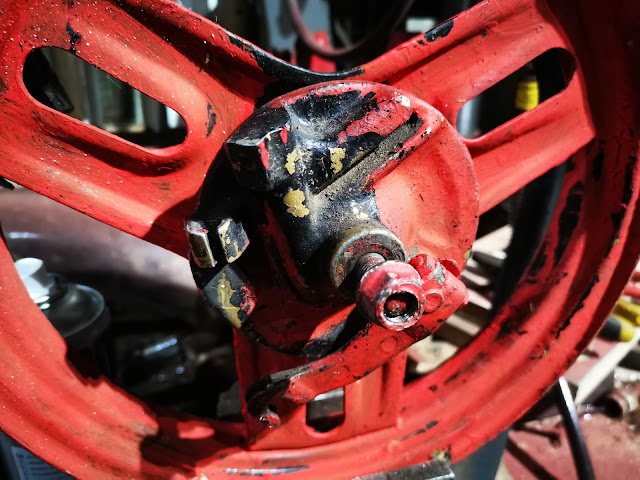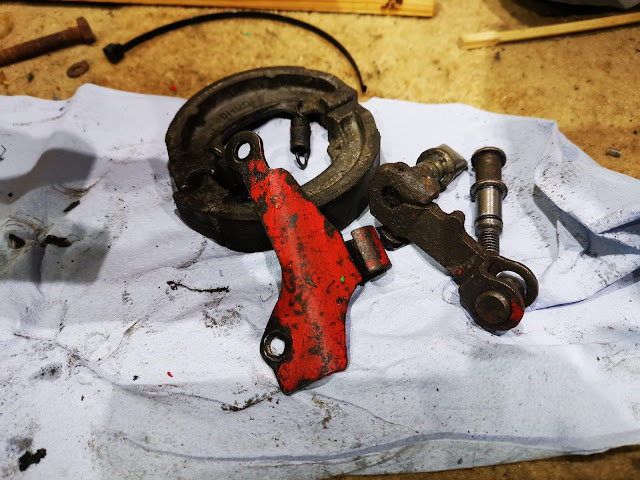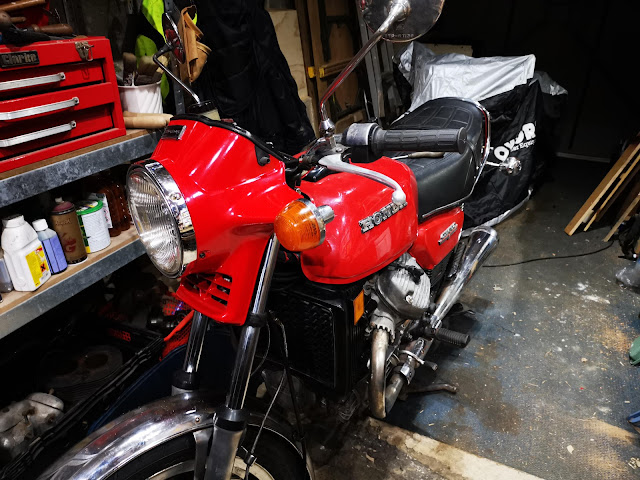Today I had a chance to look at the boxes of QR50 bits. My oldest grandson is 5 in a few weeks and I need to get this bike together before he misses out. Lets see:
Frame
As I've shown in
previous posts, the frame is in good shape. I need to finish the footrests, but that is in hand and will be completed when all of the other problems find solutions. As you can see, I have left the stubs (to which the folding footrests will be mounted) long enough to carry the footrest rubbers for the time being.
The centre stand and it's bracket are all there, though the pivot hole in it's bracket is pretty worn. It will weld up OK.
Forks
I've assembled the forks today. The fasteners are all there and the yokes and spindle are in good shape; the bushes are completely shot; I suspect the snubbers and rebound springs are missing; one of the main springs is missing and there is no wheel spindle, though this is just a long plain bolt that I can make easily.
There are no gaiters or shrouds for the top of the sliders either. The drawings suggest that the plastic bushes are held in by circlips in the normal way - I will machine some new bushes on the lathe.
Rear Suspension
The main concern here is the metalastik bush lugs on the crankcases - one of them is cracked. I will probably let that one go for a bit, to see if it becomes a problem.
There rear suspension strut is there and will just need painting.
Wheels
The wheels are both there and just need new tyres, painting and possibly new bearings.
Brakes
Brake plates and components are all there and will just need a clean up
Engine
The engine is in a bit of a state, though nothing really serious:
- The crankshaft has the usual mushroomed thread
- There are several (about 6) cylinder head fins broken off. I'm hoping to use the AC MIG set on this and learn to weld aluminium...
- One of the barrel fins is broken, which is not really a problem.
- One of the oil pump castings is broken. Unfortunately it looks like this is special to the QR50, so we will have to get inventive... Perhaps I can machine a replacement from a slice of aluminium bar stock?
- One of the crankcase lugs, used to mount the exhaust, is broken out.
- The ignition sensor is toast. I may need to buy a complete new stator unless I can rewind the sensor coil.
- The generator coil appears to have no leads
- The generator cover is missing. Old saucepan anyone?
This is the broken part of the 2-stroke injection pump. I guess that what is missing here is a facility to operate the pump from the throttle cable, to vary the injection rate - I may elect to run the bike on premix initially.
This is the crankshaft. I'll set this up in the lathe with the fixed steady and machine it true. hopefully there will be enough length for the nut to fit?
Transmission
The transmission looks like it is all there, though the rear drive shaft bearings are missing.
Despite the empty cases in the picture, I have all of the transmission components and have had them assembled.
The kick start quadrant splines are, as usual, completely knackered. Fortunately we have an NC50 transmission with a good one.
Electrics & Controls
The coil is there and in good shape; the small main harness is also there with the CDI unit. The handlebar switches are all missing - I have the left hand lever but not the right one. There's a lot of this sort of thing available very cheaply on eBay though, so that's easily sorted.
The handlebars are a puzzle in that they have conventional clamps and conventional clamp on levers - i.e. the bars are plain. All the parts list illustrations I have seen show bars with a welded lug for the left hand lever and a welded lug for mounting the bars to the top yoke.
Given that these bars look a bit high and wide for the bike - the originals appear much lower to the yoke in some pictures. I may cut, slug and weld them up:
Or this:
I might also make a welded bracket to attach them to the yoke, per the originals:
Then again, it might be an optical illusion. The cables are all there.
Mudguards & Bodywork
The front mudguard is there and in good shape - it's bolts are also present. The rear mudguard/seat unit is holed (looks like a heavy rider wore through the mudguard with a tyre) and the seat will need a new cover.
The number plate is probably damaged beyond repair.
Fuel and Exhaust
The fuel tank is as yet unseen. The exhaust pipe is there but the silencer is missing; the carburetter is there and looks OK.
The air filter is missing, but I can easily find a pod filter.
Summing Up
This is quite challenging. The little bike is financially not worth a lot - you see them for sale at £500-600 or so. Parts are available but very expensive, so this will be a labour of love for a grandparent wishing to extend his restoration skills - this might be a 1982 bike but the skills I will learn could be used on a 1920's bike.
In order of importance:
- I need the crankshaft thread fixed in order to assemble the engine
- I need the missing bearings to assemble the transmission
- I need the forks fixed in order to get the bike to roll around, and I need at least one tyre
- I need the generator stator in order for the engine to run
- I need some handlebar controls to be able to stop the engine and to be able to brake
- I need an exhaust
Everything else I can get around - the engine will run with a shortage of head and barrel fins; it will run on premix with no oil pump (and I don't have to find all the oil lines); one tyre is probably OK since this is not a road bike; I can find an air filter from eBay; the bike will be fine with fixed footrests for a while.




























































